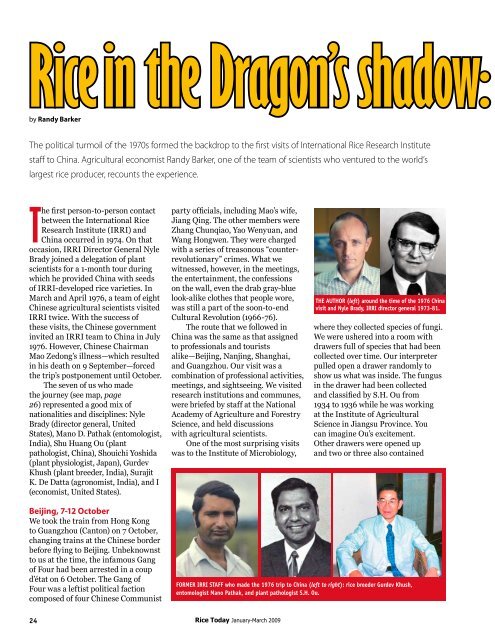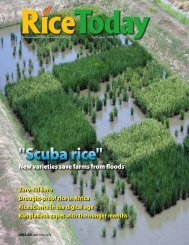How much water does rice need? - adron.sr
How much water does rice need? - adron.sr
How much water does rice need? - adron.sr
Create successful ePaper yourself
Turn your PDF publications into a flip-book with our unique Google optimized e-Paper software.
CRice in the Dragon’s shadow:by Randy BarkerThe political turmoil of the 1970s formed the backdrop to the first visits of International Rice Research Institutestaff to China. Agricultural economist Randy Barker, one of the team of scientists who ventured to the world’slargest <strong>rice</strong> producer, recounts the experience.The first person-to-person contactbetween the International RiceResearch Institute (IRRI) andChina occurred in 1974. On thatoccasion, IRRI Director General NyleBrady joined a delegation of plantscientists for a 1-month tour duringwhich he provided China with seedsof IRRI-developed <strong>rice</strong> varieties. InMarch and April 1976, a team of eightChinese agricultural scientists visitedIRRI twice. With the success ofthese visits, the Chinese governmentinvited an IRRI team to China in July1976. <strong>How</strong>ever, Chinese ChairmanMao Zedong’s illness—which resultedin his death on 9 September—forcedthe trip’s postponement until October.The seven of us who madethe journey (see map, page26) represented a good mix ofnationalities and disciplines: NyleBrady (director general, UnitedStates), Mano D. Pathak (entomologist,India), Shu Huang Ou (plantpathologist, China), Shouichi Yoshida(plant physiologist, Japan), GurdevKhush (plant breeder, India), SurajitK. De Datta (agronomist, India), and I(economist, United States).party officials, including Mao’s wife,Jiang Qing. The other members wereZhang Chunqiao, Yao Wenyuan, andWang Hongwen. They were chargedwith a series of treasonous “counterrevolutionary”crimes. What wewitnessed, however, in the meetings,the entertainment, the confessionson the wall, even the drab gray-bluelook-alike clothes that people wore,was still a part of the soon-to-endCultural Revolution (1966-76).The route that we followed inChina was the same as that assignedto professionals and touristsalike—Beijing, Nanjing, Shanghai,and Guangzhou. Our visit was acombination of professional activities,meetings, and sightseeing. We visitedresearch institutions and communes,were briefed by staff at the NationalAcademy of Agriculture and ForestryScience, and held discussionswith agricultural scientists.One of the most surprising visitswas to the Institute of Microbiology,THE AUTHOR (left) around the time of the 1976 Chinavisit and Nyle Brady, IRRI director general 1973-81.where they collected species of fungi.We were ushered into a room withdrawers full of species that had beencollected over time. Our interpreterpulled open a drawer randomly toshow us what was inside. The fungusin the drawer had been collectedand classified by S.H. Ou from1934 to 1936 while he was workingat the Institute of AgriculturalScience in Jiangsu Province. Youcan imagine Ou’s excitement.Other drawers were opened upand two or three also containedBeijing, 7-12 OctoberWe took the train from Hong Kongto Guangzhou (Canton) on 7 October,changing trains at the Chinese borderbefore flying to Beijing. Unbeknownstto us at the time, the infamous Gangof Four had been arrested in a coupd’état on 6 October. The Gang ofFour was a leftist political factioncomposed of four Chinese CommunistFORMER IRRI STAFF who made the 1976 trip to China (left to right): <strong>rice</strong> breeder Gurdev Khush,entomologist Mano Pathak, and plant pathologist S.H. Ou.24 Rice Today January-March 2009

















